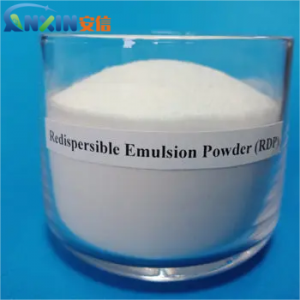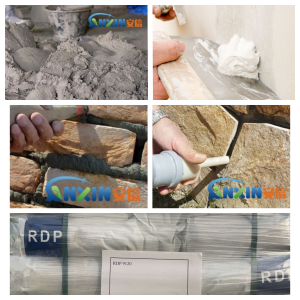Redispersible Polymer Powder (RDP), as a key organic modified component in modern building dry-mixed mortar systems, is widely used in products such as tile adhesives, exterior wall insulation mortars, putts, self-leveling materials, and cement-based waterproof materials. It can significantly improve the adhesion, flexibility, crack resistance and water resistance of mortar. However, there are numerous types of RDP on the market, and the performance differences among different manufacturers and formulations are significant. How to select the appropriate construction-grade RDP has become a key factor restricting product performance and cost control.
1. Determine the RDP type based on the application system
1.1. Tile adhesive
Tile adhesive requires high bonding strength and good anti-slip property. Ethylene-vinyl acetate copolymer (VAE) type RDP is often selected, which has excellent adhesion, flexibility and anti-aging performance. For large-sized or low water absorption rate tiles (such as porcelain tiles), modified VAE or VeoVa type RDP can be selected to enhance wet adhesion and heat aging resistance.
1.2. External Wall Thermal Insulation Mortar (EIFS)
This type of system requires RDP to provide high flexibility and impact resistance. Ethylene-vinyl ester – vinyl acetate terpolymer (EVA or VeoVa type) products should be given priority to enhance the weather resistance and long-term stability of the system.
1.3. Interior and exterior wall putty
Putty mainly requires good workability, anti-powdering property and adhesion. The VAE type RDP can meet the requirements, featuring high cost performance and good dispersion. For high-end water-resistant putty, a certain proportion of acrylic RDP can be added to enhance water resistance.
1.4. Self-leveling mortar
The self-leveling system requires that RDP enhance the adhesion and crack resistance of the base surface without affecting the fluidity. It is recommended to use low-viscosity VAE type or acrylate RDP, which takes into account both strength and flexibility.
1.5. Waterproof mortar and repair mortar
This type of product emphasizes water resistance and long-lasting adhesion. Pure acrylate or styrene-acrylate copolymer RDP has excellent waterproof performance and is an ideal choice.
2. Consideration of key performance indicators
2.1. Glass transition Temperature (Tg)
Tg directly affects the flexibility of film formation.
Low Tg (<0℃) : Suitable for thermal insulation mortar and tile adhesive with high flexibility requirements.
Medium Tg (0-15℃) : Suitable for ordinary putty and plastering mortar.
High Tg (>15℃) : Suitable for exterior wall systems with high heat resistance requirements.
2.2. Solid Content and ash Content
The higher the solid content, the more effective components of the polymer. Ash content reflects the content of fillers. The general requirement is that the solid content should be ≥98% and the ash content ≤12%.
2.3. Balance between bonding strength and flexibility
High strength and high flexibility are often difficult to achieve simultaneously. The choice should be made in combination with practical applications. For instance, tile adhesive needs to have high bonding strength; Thermal insulation mortar pays more attention to flexibility.
2.4. Water resistance and alkali resistance
When building mortar is in an alkaline environment, it is necessary to ensure that the RDP is alkali-resistant and does not degrade. Especially in external wall insulation systems, water resistance performance determines the service life of the system.
2.5. Dispersibility and film-forming property
Whether RDP can be rapidly dispersed into the original emulsion during the stirring process directly affects the uniformity of construction and the final performance. High-quality RDP should be able to disperse rapidly in cold water without caking.
3. Compatibility with other additives
Building mortar usually also contains various components such as HPMC, starch ether, defoamers and fillers. The compatibility of RDP with these additives is crucial to the stability of the system:
When combined with cellulose ethers (HPMC/MHEC), if RDP contains a relatively high amount of surfactants, it may lead to a decrease in water retention. The proportion should be adjusted through small-scale tests.
When used in conjunction with waterproofing agents or hydrophobic powders, if RDP is hydrophilic VAE, it may affect the hydrophobic effect. In such cases, acrylic RDP should be selected.
Improper compatibility with defoamers may cause severe foaming or affect the smoothness of the construction. It is recommended to conduct compatibility tests.
4. Economic and stability considerations
4.1. Cost Performance Evaluation
The price difference among different brands and types of RDP can reach over 30%. It is suggested that through performance comparison experiments, the “cost per unit of bonding strength” be calculated and the scheme with the best comprehensive performance be selected.
4.2. Batch Stability and Supply Assurance
Building materials have high requirements for formula consistency. Choosing a manufacturer with ISO quality system certification and stable supply capacity can avoid batch fluctuations.
4.3. Environmental Protection and safety standards
High-quality RDP should meet the requirements of low VOC content, no formaldehyde, and no APEO to ensure the certification needs of green building materials.
5. Selection and testing suggestions
5.1. Experimental verification takes priority
Before formal use, key properties such as adhesion, flexibility and workability should be verified through small-scale experiments.
5.2. Adjust according to the season
During high-temperature construction in summer, high Tg type RDP can be appropriately selected to prevent the decline of bonding force. For low-temperature construction in winter, products with low Tg should be selected to ensure film formation.
5.3. Match with customer requirements
For exports or engineering projects, selection should be made in accordance with local standards (such as EN12004, JC/T 547) to ensure performance compliance.
Selecting the appropriate building-grade RDP is not merely about pursuing “high indicators”, but rather a process that comprehensively considers system compatibility, performance balance, cost control and long-term stability. Only through scientific selection, thorough testing and continuous optimization can RDP achieve its maximum efficiency in dry-mixed mortar, ensuring the workability, durability and market competitiveness of the product.
Post time: Oct-29-2025








